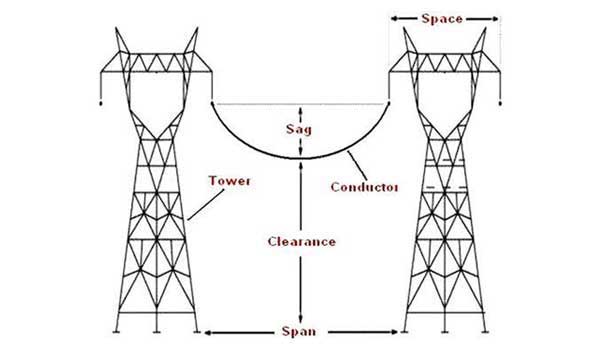Today we will know about the Sag in the transmission line. First, let’s start off with the Sag thing.
What is Sag? The word “Sag” means hanging. Who will be hanging now? If you notice the tower’s wires on the transmission line, you will see that it hangs slightly. Not in a straight line. Now draw a straight line in mind with the two points of the two towers passing through it. Now the amount of wire that hangs from this straight line is called that wire. Imagine the thing from the picture above. Then it will be straight.
Table of Contents
Now, some questions come to mind. What is the problem if Sag is less ??
It is best to have the tower cross-arm to the cross-arm sag or wire tilt to a certain extent. If the Sag is higher then the distance between one cable to the other is less. And we know that corona loss can occur by sparking air polarized if the two wires are not properly spaced.
Well, how do I put Sag to a certain level?
Using the vibration damper. When you look at the transmission lines, you will notice that they are clipped with something like a clipper. The purpose is to sag in the air so that it doesn’t grow.
Now let us know how to calculate this Sag?
1) Sag is the usual formula for calculating,
S = WL^2 / 8T
Here,
S = Sag
W = Weight of wire
L = Length of wire
T = Tension of wire after hanging
2) Now, if the two towers are not point-to-point. Especially in mountainous areas that can be seen. One tower is very high and another tower is down. In that case, it is not a straight line. Because there are no two crossarm points to the point. How do I calculate in that case?
Suppose the points of one cross arm are A, the other B. If there is a point O between them, then
S = W/2T * ( X1 – X2) * (X1 + X2)
X1 = Distance between A & O
X2 = Distance between B & O
X1 + X2 = L = Distance between A & B = Length of wire.
3) If it is raining in the rain, ice, snowfall, wind, then how can Sag be calculated?
In that case, the Weight of the conductor wire will change. Then
W = root over of (Wi + W)^2 + Ww^2
Wi = ice weight per unit length
Ww = Wind force per unit length
After extracting W, formula 3 & 2 is exactly what it needs.
What Is a Fuse?Types of Fuses And Its Application.
Electrical Circuit Breaker | Operation and Types of Circuit Breaker
Air Blast Circuit Breaker/Operation Of Air Blast Circuit Breaker


